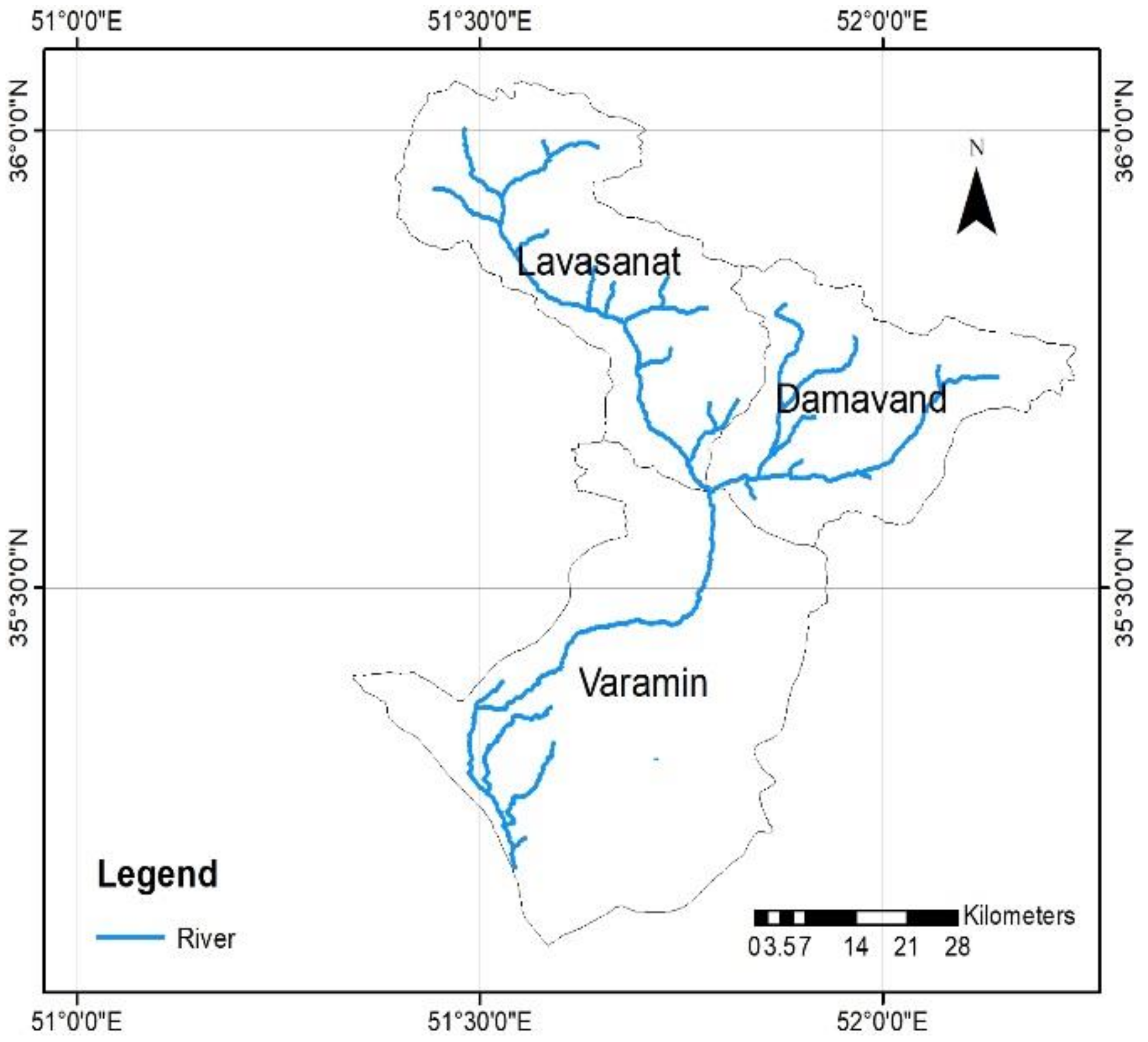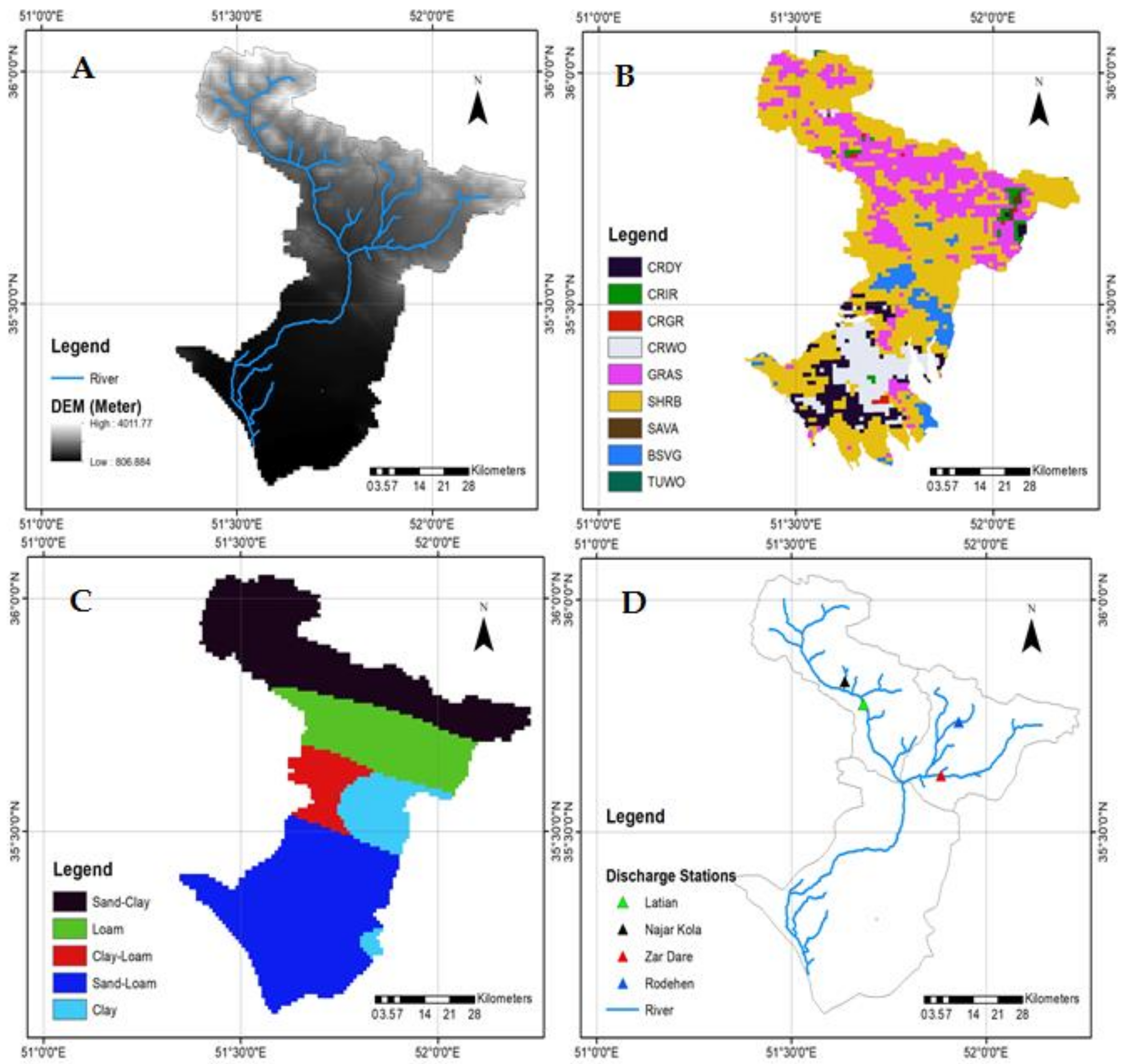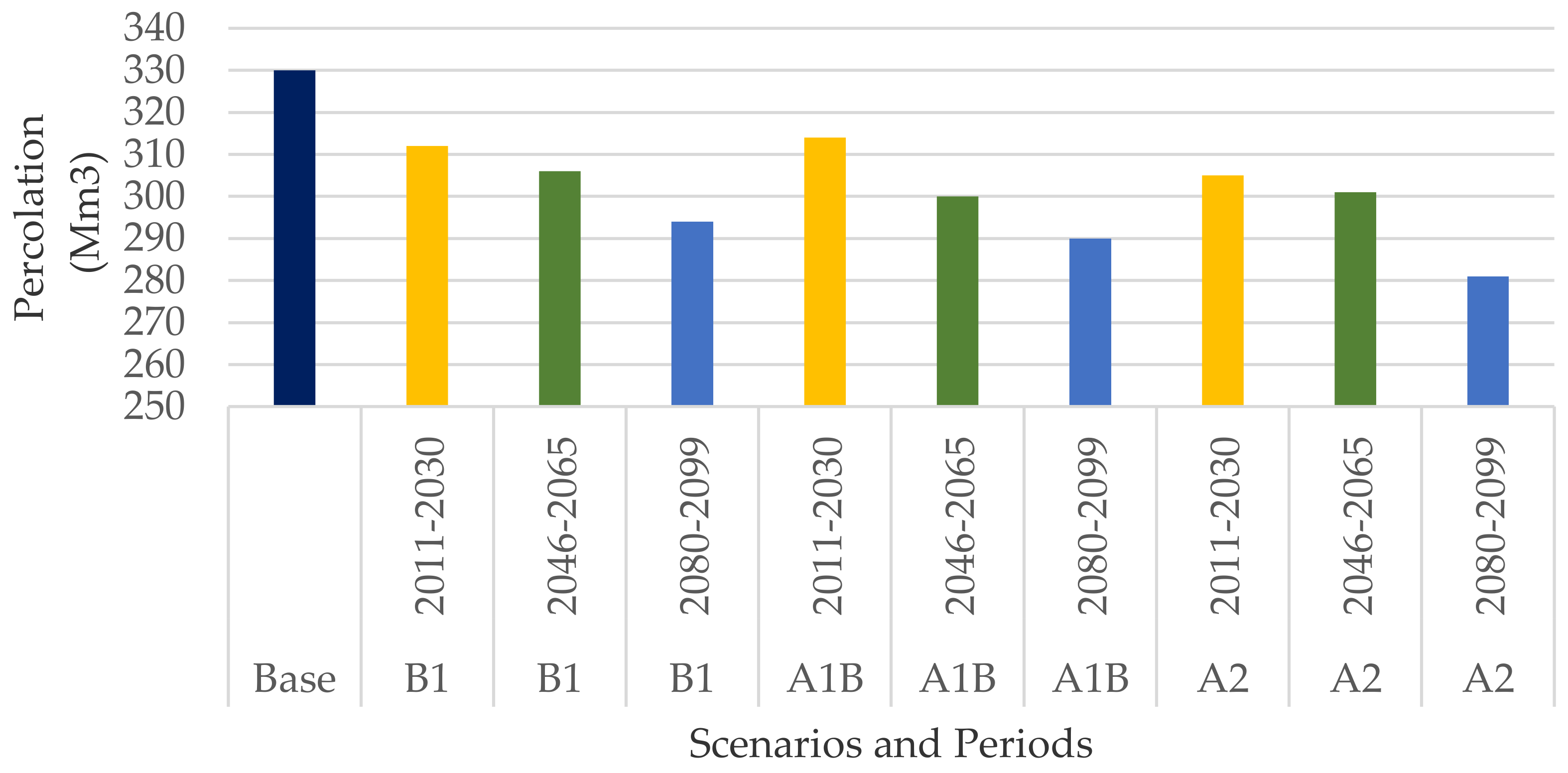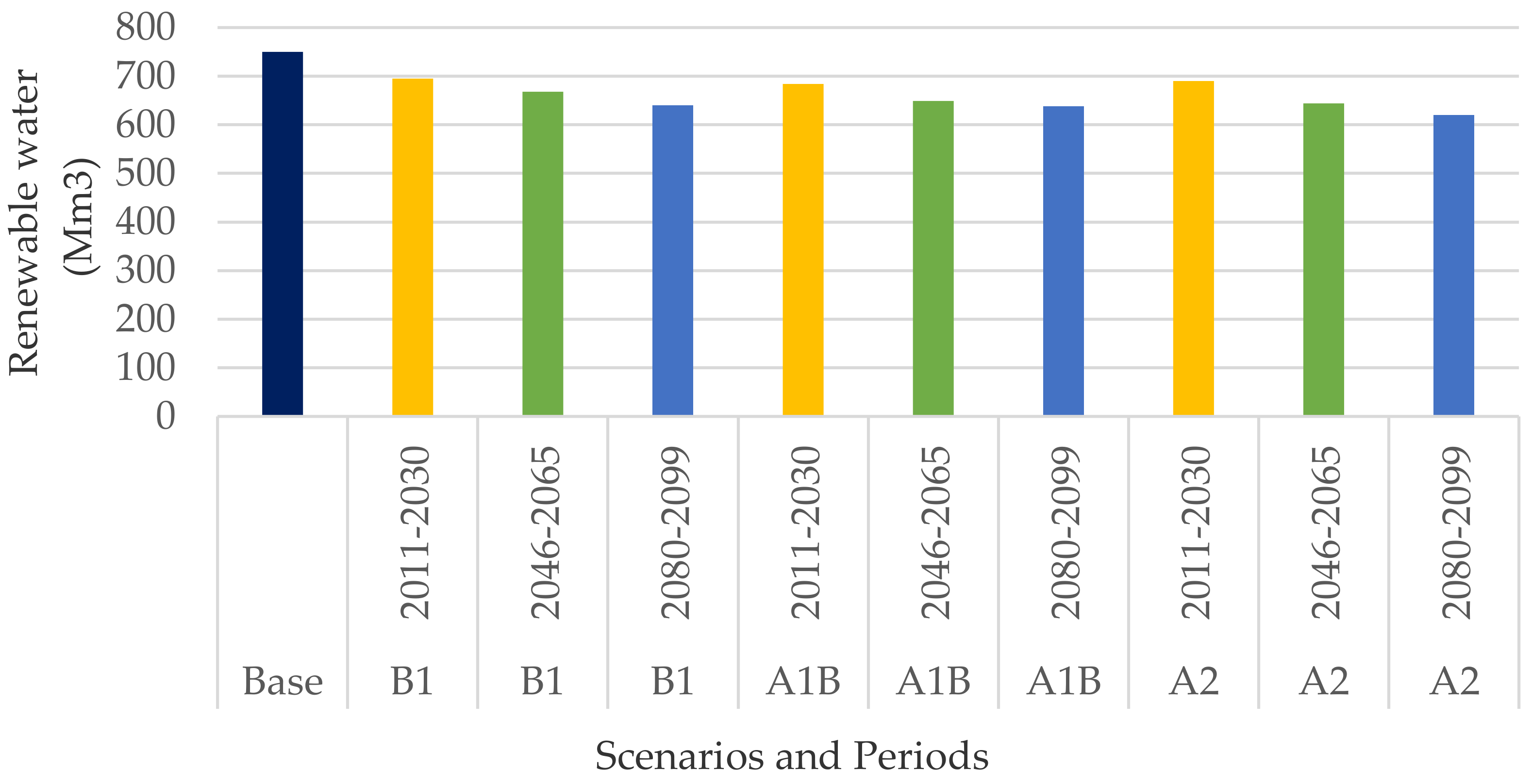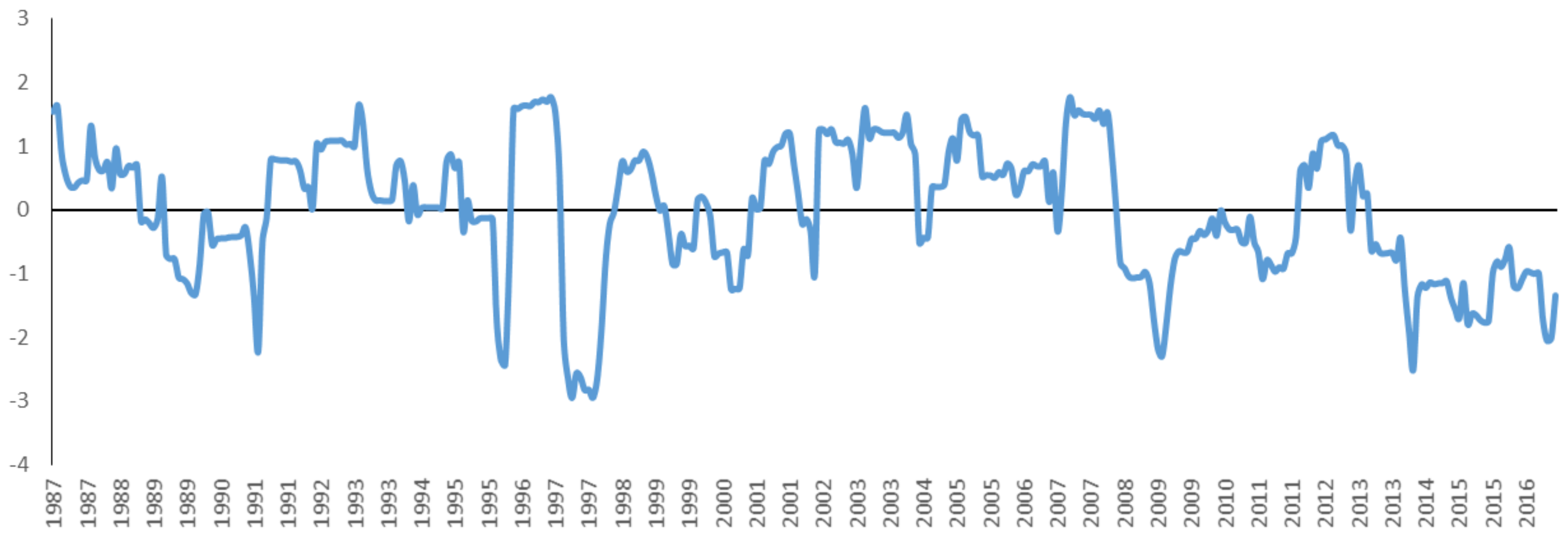The management and planning of water resources are becoming more challenging as a consequence of the uncertainties of climate change [
1]. The increase in temperature, variations in precipitation, and changes in the frequency of extreme events increase the probability of flood occurrences and change the total and seasonal water supply [
2]. Iran is considered among the arid and semi-arid areas in the global climatic zonation [
3]. Evidence from historic climatological data and forecasts of Iran’s climatic conditions, as elsewhere worldwide, indicates climate change in recent decades with an ongoing trend in the future. Climatic alterations will seriously affect water resources, a large part of which, including surface waters, ground waters, and water-related constructions, will undergo unintended consequences. Simulations using hydrological, general circulation, or regional climate models are common methods for the study of the climate change impact on water resources. Abbaspour et al. (2009) assessed the impact of climate change on water resources in Iran. They found that the wet regions of the country will receive more rainfall, while the dry regions will receive less rainfall in scenarios A1B, A2, and B1 [
4]. Ficklin et al. (2010) conducted a study on climate change effects upon basin runoff using the Soil and Water assessment tool (SWAT) model and the LARS-WG software in order to investigate the effects of climate change on sediment load, nitrate, phosphate, and agricultural fertilizer residues in San Joaquin watershed, California, downscaled by LARS-WG for 2100. Through the Special Report on Emission Scenarios (SRES) regarding CO
2 emissions by agricultural practices, they found that the rising levels of this pollutant would result in a 23% drop in runoff and a 2 °C increase in temperature [
5]. Faramarzi et al. (2013) conducted a research on climate change impact on freshwater availability in Africa. The results showed that for Africa as a whole, the mean total quantity of water resources is likely to increase. For individual subbasins and countries, variations will be substantial. Also, they showed that the number and frequency of dry days will increase in the future [
6]. Devkota and Gyawali (2015) employed the SWAT model for hydrological simulation in order to investigate the climate change effect on the management and the hydrology of Kushi River basin in Nepal. Their results showed that climate change is not a large threat to available water in that area, though the projected flow was strongly dependent on the climate change implemented in the climate model [
7]. Shrestha et al. (2016) applied the LARS-WG and SWAT models to study climate change-related runoff and sediment uncertainty in future periods of 2030 and 2060 under the Global Circulation Models (GCM) and reported an increase in sediment load and a decrease in runoff in the future [
8]. Montaseri and Amirataee (2016) used 50 years of historical precipitation data at 12 stations in different parts of the planet to produce 1000 consecutive series of artificial rainfall and compared different methods of drought monitoring. Their results showed that the Standardized Precipitation Index (SPI) method is the most accurate and realistic indicator for drought analysis [
9]. Leta et al. (2016) assessed the climate change impact on water balance components in Hawaii using the SWAT model. The predicted climate change scenarios showed that the decrease in rainfall during the wet season and the marginal increase in the dry season will be the main factors for the overall decrease in water balance components. Specifically, the groundwater flow may decrease by as much as 15% due to predicted rainfall and temperature changes by 2100 [
10]. Alipour et al. (2017), in three central provinces of Iran, using 30-year precipitation data at 20 weather stations, showed that the SPI index is more flexible in drought analysis at monthly, seasonal, and annual time scales compared to other methods [
11]. In another study, Kumar et al. (2017) investigated climate change impact on water resources in India. The results indicated that simulated annual discharge and percolation for 2020s will decrease by 2.9% and 0.8%, respectively [
12]. Marcinkowski et al. (2017) conducted a study on climate change effects upon two Lowland Catchments in Poland. The hydrological response to climate warming and wetter conditions will include lower snowmelt, increased percolation, and baseflow and higher runoff [
13]. The influences of climate changes on surface water resources in the Pangani basin were assessed by the Soil and Water assessment tools (SWAT) and Water Evaluation and Planning system (WEAP) models (Kishiwa et al., 2018). The results indicated a 10% rise in runoff and almost a 2 °C elevation in temperature during the 2050s compared to the baseline period. Irrigation is also predicted to undergo a severe shortage, necessitating current and future planning for water use [
14]. Zhou et al. (2018) assessed the quantitative effects of climate change and anthropogenic activities on runoff fluctuations in Dongjiang River basin, China, and detected an elevated annual temperature and a reduced evaporation rate. The SWAT model also displayed an acceptable performance. Furthermore, climate change impacts (58%) have been slightly greater than those of anthropogenic activities (42%) in the whole basin [
15]. Yin et al. (2018) employed the Climate Model Intercomparison Project 5 (CMIP5) and SWAT to investigate the climate change effects on Jinsha River flow. The results demonstrated a drop in runoff by 2–5% as a result of 1 °C temperature rise, with 0.5–0.8% decrease in precipitation and 1.31–1.87 °C elevation in temperature [
16]. Using the SWAT model, the impact of climate change on rice yield was studied in Nanliujiang basin, China [
17], suggesting a high ability of the SWAT model in simulating the studied basin. Rice yield increased from 1.4% to 10.6% under GFDL-ESM2M (Geophysical Fluid Dynamics Laboratory- Earth System Models) and IPSL-CM5A-LR (IPSL Earth system model for the 5
th IPCC report) climate models, while HadGEM2-ES model (Hadley Global Environmental Multiscale Models) resulted in a dropped yield (Yang et al., 2018). In Awash basin, Ethiopia, Daba (2018) conducted a study on runoff sensitivity to temperature and precipitation and observed a high runoff sensitivity to both variables, so that annual temperature rises of 1, 2, 3, 4, and 5 °C led to annual runoff reductions to −0.085, −0.88, −1.75, −2.55, and −3.30% [
18]. In a study on the evaluation of climate change impact on Kan basin runoff (Hajimohammadi et al., 2018), runoff was simulated monthly by the SWAT hydrological model. The results indicated decreasing precipitation and rising temperatures in all selected stations. The developed climate scenarios finally demonstrated increasing and decreasing runoff levels in winter and other seasons, respectively. This present study evaluated climate change impact on runoff and drought in Salt Lake subbasins [
19]. In another study, Montecelos-Zamora et al. (2018) assessed the potential impacts of climate change on water availability in the Cauto River basin. The future projections suggest a regional increase of 1.5 °C in annual temperature and a 38% decrease in annual precipitations in the subbasins. These changes translate to possible reductions in the annual streamflow of up to 61% with respect to the baseline period, whereas the aquifer recharge in the basin is expected to decrease up to 58%, with a consequent reduction of groundwater flow, especially during the boreal summer wet seasons [
20]. Eini et al. (2018) evaluated runoff by the SWAT model and estimated drought intensity by the SPI index using Asfazari national database. Their results showed high accuracy of the Asfazari database in simulating runoff and drought severity [
21].
Given different climate changes around the world, Iran cannot be excluded from these large-scale changes, the consequences of which are observed in many Iranian basins. As seen, very few studies have evaluated the effects of climate change on renewable water resources. The innovation aspect of this study is that we not only estimated the impacts of climate change on surface water, groundwater, and renewable resources, but also predicted drought intensity in future periods under different climate scenarios.
